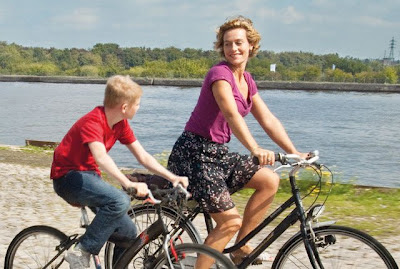Cyril is a troubled adolescent in search of
emotional support. He’s rebellious and angry—fighting, biting
and causing self-inflicted wounds. His father abandoned him and he’s
forced to live in foster care. The only emotional attachment is a
bike, which he recovered after his father sold it for money.
The Kid with a Bike follows the uncomplicated, yet poignant journey of a lost boy in need. Similar to Truffaut’s groundbreaking new-wave film, The 400 Blows (1959) and borrowing minimalistic elements from Italian Neo-realism, The Kid with a Bike prospers in keen observation, rather than a self-indulgent style. The camera is appropriately hand-held and utilizes a more natural cinematography, and lacks a musical score.
The primary focus is the turbulent, implosive anguish of Cyril, and the audience empathizes with his pain. The filmmakers don’t waste any time establishing the central conflict. In the opening scene at the foster home, Cyril is on the phone, trying to track down his absentee father. He uses every resource he has to try and fill his void. The film is also about the heartbreaking realization that Cyril can never get his needs met. The bike is a symbol of the love he’ll never receive—an extension of the past he yearns for.
The plot advances when the town hairdresser, Samantha, agrees to extend a helping hand, and take care of Cyril on the weekends. In his attempt to salvage a vanished relationship with his father, Cyril is blinded by the newfound love he has right next to him, which is Samantha. When angry boys can’t find love from within their family, they go searching for it in dangerous places—acceptance can mean a lot, even if it’s from bad influences. The boy is lured by a conniving teenager, who uses him for criminal activity. There’s a scene where the teenager takes him home to his house and lets him play a videogame in his room. Since there isn’t any dramatic music or extraneous close-ups, it’s hard to tell how the situation will develop. The minimal style truly increases the suspense and intrigue.
Towards the end of the film, the writers-and-directors imply a change in the boy’s erratic behavior. In the scene where Samantha and Cyril are riding together, Cyril suggests to try riding Samantha’s mountain bike. The scene conveys Cyril’s willingness to let go of the past and try something new—accepting the reality of his situation. The filmmakers express this message by visual action, rather than explain it in dialogue or voice-over. The Kid with a Bike ends on a sad, yet thoughtful note. The very last scene surmises everything that Cyril’s missing; the protective bond between father and son.
*** ½ (out of four stars)
The Kid with a Bike follows the uncomplicated, yet poignant journey of a lost boy in need. Similar to Truffaut’s groundbreaking new-wave film, The 400 Blows (1959) and borrowing minimalistic elements from Italian Neo-realism, The Kid with a Bike prospers in keen observation, rather than a self-indulgent style. The camera is appropriately hand-held and utilizes a more natural cinematography, and lacks a musical score.
The primary focus is the turbulent, implosive anguish of Cyril, and the audience empathizes with his pain. The filmmakers don’t waste any time establishing the central conflict. In the opening scene at the foster home, Cyril is on the phone, trying to track down his absentee father. He uses every resource he has to try and fill his void. The film is also about the heartbreaking realization that Cyril can never get his needs met. The bike is a symbol of the love he’ll never receive—an extension of the past he yearns for.
The plot advances when the town hairdresser, Samantha, agrees to extend a helping hand, and take care of Cyril on the weekends. In his attempt to salvage a vanished relationship with his father, Cyril is blinded by the newfound love he has right next to him, which is Samantha. When angry boys can’t find love from within their family, they go searching for it in dangerous places—acceptance can mean a lot, even if it’s from bad influences. The boy is lured by a conniving teenager, who uses him for criminal activity. There’s a scene where the teenager takes him home to his house and lets him play a videogame in his room. Since there isn’t any dramatic music or extraneous close-ups, it’s hard to tell how the situation will develop. The minimal style truly increases the suspense and intrigue.
Towards the end of the film, the writers-and-directors imply a change in the boy’s erratic behavior. In the scene where Samantha and Cyril are riding together, Cyril suggests to try riding Samantha’s mountain bike. The scene conveys Cyril’s willingness to let go of the past and try something new—accepting the reality of his situation. The filmmakers express this message by visual action, rather than explain it in dialogue or voice-over. The Kid with a Bike ends on a sad, yet thoughtful note. The very last scene surmises everything that Cyril’s missing; the protective bond between father and son.
*** ½ (out of four stars)

Brings to mind "Rosebud!" take it from there Yale!
ReplyDelete